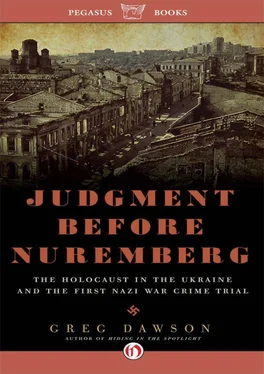In Kharkov, newspapers announced that churches would give a prayer of thanks on the first anniversary of the German occupation of the city. Another leader of the Autocephalous Church sent Hitler a telegram on April 5, 1942, wishing him happy birthday and rapid success in the war. The telegram was sent three months after the Nazis marched 16,000 Jews through the streets of Kharkov, under the horrified gaze and occasional anti-Semitic taunts of onlookers, to the tractor factory and then to slaughter at Drobitsky Yar. Even the monkeys who hear, see, and speak no evil would have had difficulty pleading ignorance of these events, which did not take place in barbed-wire–enclosed death camps on the edge of town, but rather on city streets and in open fields.
Averting their gaze from Nazi atrocities was a fulltime job for church leaders in Kharkov. In the first two weeks of the occupation, their “liberators” hung 116 people from lamp posts, balconies, and trees on Sumskaya Street in the center of the city. A magnificent statue of Shevchenko, the Ukrainian national poet, was festooned with corpses. Starvation was another favored weapon of the Nazis against both civilians and prisoners of war. General Field Marshal Walter von Reichenau, in his directive “The Conduct of the Army in the East,” minced no words. “Supplying the civilian population and prisoners of war with food is an unnecessary humanitarian act. It is like giving away cigarettes and bread—an example of misdirected compassion.”
The bulk of local harvests and food was confiscated to feed the occupying army or shipped to Germany. The daily bread ration for residents of Kharkov was 5.25 ounces. For Jews, it was 2 ounces. The German command expected at least ten to twenty million people in the East to starve to death during the winter of 1941–42. Soldiers were given a mantra to repeat if they felt they were losing their nerve and about to commit an unnecessary humanitarian act: “Each gram of bread or other food that I give to the population in the occupied territories out of good-heartedness, I am withdrawing from the German people and thus my family. The German soldier must stay hard in the face of hungry women and children. If he does not, he endangers the nourishment of our people.”
Apparently it worked, at least in Kharkov. “As early as December 1941, starvation was quite frequent, even among the non-Jewish population, and by March 1942, almost half as many people were starving to death in Kharkov each month as in the Warsaw ghetto,” wrote historian Dieter Pohl. My mother remembers going through German garbage for potato skins her mother could use for making soup, and later, while hiding in an orphanage, scrounging for much less savory things than potato skins. Upwards of 100,000 residents of Kharkov are thought to have died of hunger during the German occupation.
N.F. Belonozhko was the wife of a soldier. She kept a diary of daily life in Kharkov during the occupation. Her fate is unknown, but Belonozhko’s notes were retrieved and published in The Unknown Black Book, the Danteesque testimony of those consigned by fate to Himmler’s “Garden of Eden.” What follows are excerpts from Belonozhko’s diary.
“Winter began fiercely this year. No one had a stove. There was no fire wood either. I am working in a cafeteria. Today it’s borscht from frozen beets without bread, then kozein, a glue-like, repulsive white substance (made from bones); it tasted like rubber. They say it was used in building airplanes…. The first to get sick in our room is Shura and Sonya’s mother. Sonya would go to a village to the south to get her milk. Her mother dies slowly. And now in our apartment is the first coffin, made from a chest of drawers.
“In the kitchen in the evenings, everyone looks nervously at their legs, squeezing them. Are they swollen? Sonya’s and Nyura’s are very swollen, and the Mordukhaev girls are just wasting away. They look like they are made of wax. They don’t comb their hair, they don’t wash, they make something out of potato peelings and snow and eat it. People live by selling things but they’ve got nothing left to sell.
“Lice are crawling around the apartment…. Another one of us has died. Sonya died in the hospital. Her feet became infected and she died of blood poisoning. They buried her in a common grave. There’s no one left to recall the past, our life before the Germans. There’s no one to dream about. Margarita has gotten sick, too. When will this end? When?” [6] The Unknown Black Book (Indiana University Press, Bloomington, 2008), 104–105.
August 23, 1943. That is when it ended, on a Thursday morning.
“By dawn on August 23, the 89th Guards and 183rd Divisions had reached Dzerzhinsky Square, the 89th hoisting its red banner over the Gosprom building,” wrote historian Karel Margry. “However, the Russians bagged few of the enemy. The German units had completed their withdrawal from the city, occupying defensive positions south of the Uda River. At noon, the Russians declared the city clear of German troops.”
Not completely. Three lower-level German officers had drawn the shortest of short straws fate could deliver to a Nazi invader, leaving them behind in the hands of the Soviets who would use them to show the world the price to be paid by those who blindly saluted Hitler and perpetrated atrocities in his name.
Since the Holocaust as we know it—the mass extermination of European Jews—began in my mother’s back yard in Ukraine, it should come as no surprise that the legal road to Nuremberg also began there. It should come as no surprise, but still does nearly seventy years after a military tribunal in Kharkov began the wheels of justice grinding slowly toward the grand denouement in Nuremberg, thence to Jerusalem and the trial of Adolf Eichmann in 1961.
It was in a makeshift courtroom in Kharkov in December 1943 that Nazis were first tried and convicted for wartime crimes, 705 days before chief U.S. counsel Robert Jackson made his opening statement before the International Military Tribunal (IMT) at the Palace of Justice in Nuremberg. In all my travels since publication of Hiding in the Spotlight in 2009, I have encountered no one who knew of the Kharkov trial—even amongst university professors and museum curators—and not many who were aware that the mass slaughter of Jews began in Ukraine.
Judge Jackson knew where the road to Nuremberg began, and why. The Nazi drive to exterminate the Jews “achieved its zenith of savagery in the East. The Eastern Jew has suffered as no people ever suffered,” Jackson told the International Military Tribunal. “It was against the Soviet people and Soviet prisoners that Teutonic fury knew no bounds.” And it was in the East, before the Soviet people in Kharkov, that Nazis first faced legal fury for their crimes in a trial whose testimony and precedents would echo in the chambers at Nuremberg.
The Kharkov trial, and an earlier one at Krasnodar involving only Soviet collaborators, were “the first judicial record of cases on the crimes and criminal responsibility of the Hitlerites… paving the way for the application and effectuation of many norms and principles which later constituted the basis of Nuremberg law,” [1] I.A. Lediakh, “The Application of the Nuremberg Principles by Other Military Tribunals and National Courts,” in The Nuremberg Trial and International Law , ed. George Ginsburgs and V.N. Kudriavtsev (Martinus Nijhoff Publishers, 1990), 263–264.
wrote I.A. Lediakh.
Soviet Foreign Minister Molotov was confident that there would be a day of legal reckoning, even in the dark early days of the war as the Wehrmacht rolled inexorably east, raping the Motherland in ways unseen in modern warfare. He could not have guessed that it would be on the stage of an opera house in Kharkov. Molotov began building a public record of Nazi crimes and atrocities within months of the German invasion in June 1941. In November, he issued an official note accusing the Nazis of violating the Hague Conventions of 1907 by shooting prisoners of war, starving others, including civilians, to death, looting their personal belongings, and conscripting them for military work.
Читать дальше












